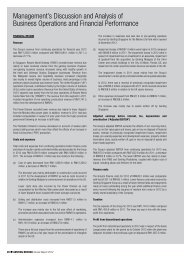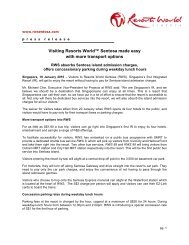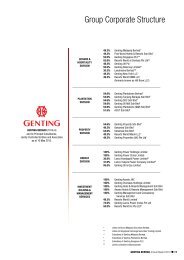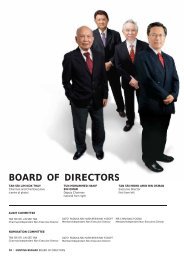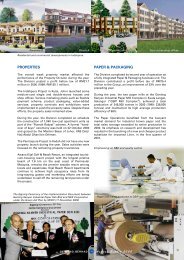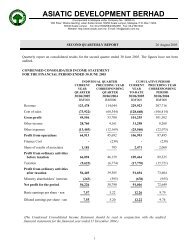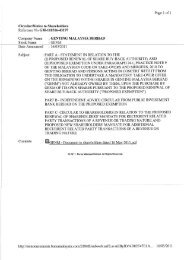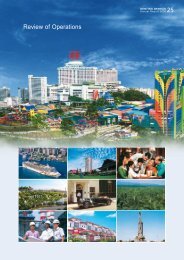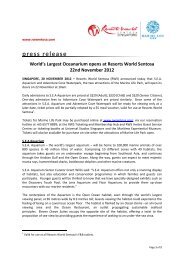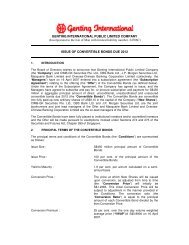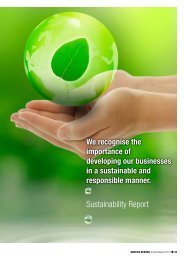Contents - Genting Group
Contents - Genting Group
Contents - Genting Group
You also want an ePaper? Increase the reach of your titles
YUMPU automatically turns print PDFs into web optimized ePapers that Google loves.
GENTING BERHAD • Annual Report 2001<br />
3. SIGNIFICANT ACCOUNTING POLICIES (Cont'd)<br />
Property, Plant and Equipment<br />
Property, plant and equipment are stated at cost modified by the revaluation of certain property, plant and equipment less<br />
accumulated depreciation and amortisation. In accordance with the transitional provisions issued by the Malaysian Accounting<br />
Standards Board ("MASB") on adoption of MASB No. 15, Property, Plant and Equipment, the valuation of these assets have<br />
not been updated, and they continue to be stated at their existing carrying amounts less accumulated depreciation.<br />
Surpluses arising on revaluation are credited to revaluation reserve. Any deficit arising from revaluation is charged against<br />
the revaluation reserve to the extent of a previous surplus held in the revaluation reserve for the same asset. In all other<br />
cases, a decrease in carrying amount is charged to income statement. On disposal of revalued assets, amounts in revaluation<br />
reserve relating to those assets are transferred to retained earnings.<br />
Freehold land and plantations and property, plant and equipment which are under construction are not depreciated.<br />
Leasehold properties are amortised equally over their respective periods of lease, ranging from 60 to 99 years. However,<br />
leasehold properties with original lease period of 999 years are not amortised, the cumulative effect of which is not material<br />
to the financial statements.<br />
Other property, plant and equipment are depreciated over their estimated useful lives using the straight-line method. The<br />
annual rates of depreciation used for the major classes of property, plant and equipment are as follows:<br />
Buildings and improvements 2% - 50%<br />
Plant, equipment and vehicles 5% - 50%<br />
Where the carrying amount of an asset is greater than its estimated recoverable amount, it is written down immediately to its<br />
recoverable amount. In determining the recoverable amount of items of property, plant and equipment, expected future<br />
cashflows have not been discounted to their present value.<br />
New Planting and Replanting Expenditure<br />
New planting expenditure incurred on land clearing and upkeeping of trees to maturity is capitalised under freehold and<br />
leasehold land respectively. New planting expenditure capitalised is not amortised.<br />
Replanting expenditure is charged to the income statement in the financial year in which the expenditure is incurred.<br />
Real Property Assets, Property Development and Profit Recognition<br />
Real property assets and property development comprise land held for development and development expenditure and are<br />
stated at cost of acquisition modified by the revaluation of certain pieces of land. In accordance with the transitional provisions<br />
issued by the Malaysian Accounting Standards Board on adoption of Malaysian Accounting Standard No. 7, Accounting for<br />
Property Development, the valuation of these pieces of land have not been updated, and they continue to be stated at their<br />
carrying amounts. Cost of acquisition includes all related costs incurred on activities necessary to prepare the land for its<br />
intended use. These assets remain as real property assets until the sales launch of these properties, after which they are<br />
transferred to property development.<br />
Assets under property development comprise land at carrying values and all related development costs incurred and are<br />
carried forward together with profit accrued to the appropriate stage of completion less progress billings and allowance for<br />
foreseeable losses, if any. These developments are expected to be completed within normal operating cycle of one to three<br />
years and are considered as current assets.<br />
Upon completion of development, the unsold completed development properties are transferred to inventories.<br />
Profits on property development projects are recognised based on the percentage of completion method in respect of sales<br />
where agreements have been finalised. Under this method, profits are recognised as the property project activity progresses.<br />
The stage of completion is determined based on the proportion of development costs incurred for work performed up to the<br />
balance sheet date over the estimated total development cost to completion. Foreseeable losses, if any, are recognised in<br />
the income statement.<br />
Investments<br />
Long term investments, both quoted and unquoted, include investments in subsidiary companies, associated companies<br />
and other non-current investments. These investments are stated at cost except where the Directors are of the opinion that<br />
there is a permanent diminution in the value of an investment, in which case the investment is written down. Permanent<br />
diminution in the value of an investment is recognised as an expense in the financial period in which it arises.<br />
39




